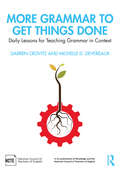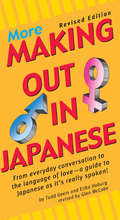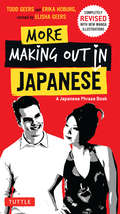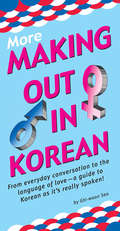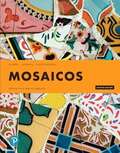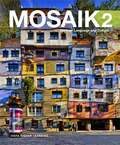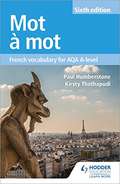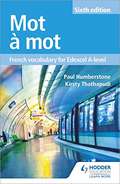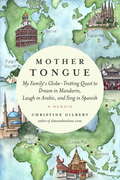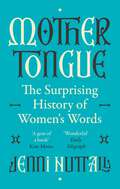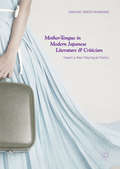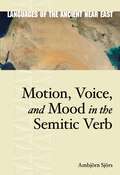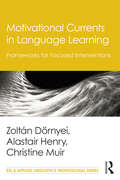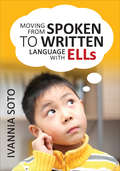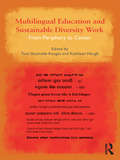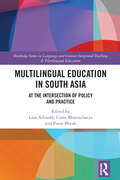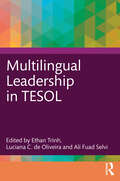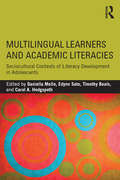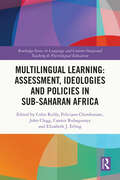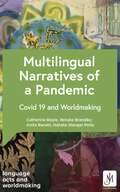- Table View
- List View
More Grammar to Get Things Done: Daily Lessons for Teaching Grammar in Context
by Michelle D. Devereaux Darren CrovitzCO-PUBLISHED BY ROUTLEDGE AND THE NATIONAL COUNCIL OF TEACHERS OF ENGLISH Complementing Crovitz and Devereaux’s successful Grammar to Get Things Done, this book demystifies grammar in context and offers day-by-day guides for teaching ten grammar concepts, giving teachers a model and vocabulary for discussing grammar in real ways with their students. Through applied practice in real-world contexts, the authors explain how to develop students’ mastery of grammar and answer difficult questions about usage, demonstrating how grammar acts as a tool for specific purposes in students’ lives. Accessibly written and organized, the book provides ten adaptable activity guides for each concept, illustrating instruction from a use-based perspective. Middle and high school preservice and inservice English teachers will gain confidence in their own grammar knowledge and learn how to teach grammar in ways that are uniquely accessible and purposeful for students.
More Making Out in Japanese
by Glen Mccabe Todd Geers Erika GeersMaking Out in Japanese is a fun, accessible and thorough guide to the Japanese language as it's really spoken.Sugoku suki! Mata aeru?--(I'm crazy about you! Shall we meet again?) Answer this correctly in Japanese and you may be going on a hot date. Incorrectly, and you could be hurting someone's feelings or getting a slap! Japanese classes and textbooks tend to spend a lot of time rehearsing for the same fictitious scenarios but chances are while in Japan you will spend a lot more time trying to make new friends or start new romances--something you may not be prepared for.If you are a student, businessman or tourist traveling to Japan and would like to have an authentic and meaningful experience, the key is being able to speak like a local. This friendly and easy-to-use phrasebook makes this possible. Making Out in Japanese has been updated and expanded to be even more helpful as a guide to modern colloquial Japanese for use in everyday informal interactions--giving access to the sort of catchy Japanese expressions that aren't covered in traditional language materials. As well as the Romanized forms (romanji), each expression is now given in authentic Japanese script (kanji and kana with furigana pronunciation clues), so that in the case of difficulties the book can be shown to the person the user is trying to communicate with.This phrasebook includes:A guide to pronouncing Japanese words correctlyExplanations of basic Japanese grammar, such as, intonation, word stress, and particlesA guide to male and female usageRomanized forms of words and phrases (romanji)Complete Japanese translations including Japanese characters (kanji) and the Japanese alphabet (kana)Useful and interesting notes on Japanese language and cultureLots of colorful, fun and useful expressions not covered in other phrasebooksTitles in this unique series of bestselling phrase books include: Making Out in Chinese, Making Out in Indonesian, Making Out in Thai, Making Out in Korean, Making Out in Hindi, Making Out in Japanese, Making Out in Vietnamese, Making Out in Burmese, Making Out in Tagalog, Making Out in Hindi, Making Out in Arabic, Making Out in English, More Making Out in Korean, and More Making Out in Japanese.
More Making Out in Japanese
by Glen Mccabe Todd Geers Erika GeersMaking Out in Japanese is a fun, accessible and thorough guide to the Japanese language as it's really spoken.Sugoku suki! Mata aeru?--(I'm crazy about you! Shall we meet again?) Answer this correctly in Japanese and you may be going on a hot date. Incorrectly, and you could be hurting someone's feelings or getting a slap! Japanese classes and textbooks tend to spend a lot of time rehearsing for the same fictitious scenarios but chances are while in Japan you will spend a lot more time trying to make new friends or start new romances--something you may not be prepared for.If you are a student, businessman or tourist traveling to Japan and would like to have an authentic and meaningful experience, the key is being able to speak like a local. This friendly and easy-to-use phrasebook makes this possible. Making Out in Japanese has been updated and expanded to be even more helpful as a guide to modern colloquial Japanese for use in everyday informal interactions--giving access to the sort of catchy Japanese expressions that aren't covered in traditional language materials. As well as the Romanized forms (romanji), each expression is now given in authentic Japanese script (kanji and kana with furigana pronunciation clues), so that in the case of difficulties the book can be shown to the person the user is trying to communicate with.This phrasebook includes:A guide to pronouncing Japanese words correctlyExplanations of basic Japanese grammar, such as, intonation, word stress, and particlesA guide to male and female usageRomanized forms of words and phrases (romanji)Complete Japanese translations including Japanese characters (kanji) and the Japanese alphabet (kana)Useful and interesting notes on Japanese language and cultureLots of colorful, fun and useful expressions not covered in other phrasebooksTitles in this unique series of bestselling phrase books include: Making Out in Chinese, Making Out in Indonesian, Making Out in Thai, Making Out in Korean, Making Out in Hindi, Making Out in Japanese, Making Out in Vietnamese, Making Out in Burmese, Making Out in Tagalog, Making Out in Hindi, Making Out in Arabic, Making Out in English, More Making Out in Korean, and More Making Out in Japanese.
More Making Out in Japanese
by Todd Geers Erika Hoburg"Making Out in Japanese" is a fun, accessible and thorough guide to the Japanese language as it's really spoken. "Sugoku suki Mata aeru?"OCo(IOCOm crazy about you Shall we meet again?) Answer this correctly in Japanese and you may be going on a hot date. Incorrectly, and you could be hurting someoneOCOs feelings or getting a "slap " Japanese classes and textbooks tend to spend a lot of time rehearsing for the same fictitious scenarios but chances are while in Japan you will spend a lot more time trying to make new friends or start new romancesOCosomething you may not be prepared for. If you are a student, businessman or tourist traveling to Japan and would like to have an authentic and meaningful experience, the key is being able to speak like a local. This friendly and easy-to-use phrasebook makes this possible. "Making Out in Japanese" has been updated and expanded to be even more helpful as a guide to modern colloquial Japanese for use in everyday informal interactionsOCogiving access to the sort of catchy Japanese expressions that aren't covered in traditional language materials. As well as the Romanized forms ("romanji"), each expression is now given in authentic Japanese script ("kanji and kana" with "furigana" pronunciation clues), so that in the case of difficulties the book can be shown to the person the user is trying to communicate with. This phrasebook includes: A guide to pronouncing Japanese words correctlyExplanations of basic Japanese grammar, such as, intonation, word stress, and particlesA guide to male and female usageRomanized forms of words and phrases ("romanji")Complete Japanese translations including Japanese characters ("kanji") and the Japanese alphabet ("kana")Useful and interesting notes on Japanese language and cultureLots of colorful, fun and useful expressions not covered in other phrasebooks Titles in this unique series of bestselling phrase books include: "Making Out in Chinese, Making Out in Indonesian, Making Out in Thai, Making Out in Korean, Making Out in Hindi, Making Out in Japanese, Making Out in Vietnamese, Making Out in Burmese, Making Out in Tagalog, Making Out in Hindi, Making Out in Arabic, Making Out in English, More Making Out in Korean, and More Making Out in Japanese. ""
More Making Out in Korean: (Korean Phrasebook)
by Ghi-Woon SeoMore Making Out in Korea is a fun, accessible and thorough Korean phrase book and guide to the Korean language as it's really spoken.<P><P>This prasebook follows the bestselling Making Out in Korea providing additional (and classic) phrases for travelers, including ones to help you make acquaintances, discuss likes and dislikes, share a meal, go out on the town or develop a romantic relationship.This Korean phrasebook includes: A guide to pronouncing Korean words correctly. Explanations of basic Korean grammar, such as, word order, questions, and formal vs. informal tenses. Complete Korean translations including Korean Script (hangul). Useful and interesting notes on Korean language and culture. Lots of colorful, fun and useful expressions not covered in other phrasebooks.
Mosaicos: Spanish as a World Language
by Judith Liskin-Gasparro Elizabeth Guzmán Paloma LapuertaFor courses in Elementary Spanish <p><p>A communicative program that places culture front and center Mosaicos: Spanish as a World Language offers instructors the truly communicative, deeply culture-focused approach they seek while providing the guidance and tools students need to be successful using a program with highly communicative goals. With Mosaicos, there is no need to compromise. Recognizing the importance of the relationship between culture and language, the authors place culture front and center throughout, creating for students a multifaceted experience of the intricate mosaic of the Spanish language and its cultures. The Seventh Edition offers new Integrated Performance Assessments that make measuring learning outcomes easier than ever.
Mosaik 2: German Language and Culture
by Christine Anton Tobias Barske Megan McKinstryNIMAC-sourced textbook
Mot à Mot Sixth Edition: French Vocabulary For Aqa A-level
by Paul Humberstone Kirsty ThathapudiEssential vocabulary for AQA A-level French, all in one place.- Supplement key resources such as course textbooks with all the vocab students need to know in one easy-to-navigate place, completed updated to match the latest specification - Ensure extensive vocab coverage with topic-by-topic lists of key words and phrases, including a new section dedicated to film and literature - Test students' knowledge with end-of-topic activities designed to deepen their understanding of word patterns and relationships - Develop effective strategies for learning new vocab and dealing with unfamiliar words
Mot à Mot Sixth Edition: French Vocabulary For Edexcel A-level
by Paul Humberstone Kirsty ThathapudiEssential vocabulary for Edexel A level French, all in one place.- Supplement key resources such as course textbooks with all the vocab students need to know in one easy-to-navigate place, completed updated to match the latest specification - Ensure extensive vocab coverage with topic-by-topic lists of key words and phrases, including a new section dedicated to film and literature - Test students' knowledge with end-of-topic activities designed to deepen their understanding of word patterns and relationships - Develop effective strategies for learning new vocab and dealing with unfamiliar words
Mot à Mot Sixth Edition: French Vocabulary for AQA A-level
by Paul Humberstone Kirsty ThathapudiExam board: AQALevel: A-levelSubject: FrenchFirst teaching: September 2016First exams: Summer 2017Essential vocabulary for AQA A-level French, all in one place.- Supplement key resources such as course textbooks with all the vocab students need to know in one easy-to-navigate place, completed updated to match the latest specification - Ensure extensive vocab coverage with topic-by-topic lists of key words and phrases, including a new section dedicated to film and literature - Test students' knowledge with end-of-topic activities designed to deepen their understanding of word patterns and relationships - Develop effective strategies for learning new vocab and dealing with unfamiliar words
Mot à Mot Sixth Edition: French Vocabulary for Edexcel A-level
by Paul Humberstone Kirsty ThathapudiExam board: EdexcelLevel: A-levelSubject: FrenchFirst teaching: September 2016First exams: Summer 2017Essential vocabulary for Edexel A level French, all in one place.- Supplement key resources such as course textbooks with all the vocab students need to know in one easy-to-navigate place, completed updated to match the latest specification - Ensure extensive vocab coverage with topic-by-topic lists of key words and phrases, including a new section dedicated to film and literature - Test students' knowledge with end-of-topic activities designed to deepen their understanding of word patterns and relationships - Develop effective strategies for learning new vocab and dealing with unfamiliar words
Mother Tongue: My Family's Globe-Trotting Quest to Dream in Mandarin, Laugh in Arabic, and Sing in Spanish
by Christine GilbertOne woman's quest to learn Mandarin in Beijing, Arabic in Beirut, and Spanish in Mexico, with her young family along for the ride. Imagine negotiating for a replacement carburetor in rural Mexico with words you're secretly pulling from a pocket dictionary. Imagine your two-year-old asking for more niunai at dinner--a Mandarin word for milk that even you don't know yet. Imagine finding out that you're unexpectedly pregnant while living in war-torn Beirut. With vivid and evocative language, Christine Gilbert takes us along with her into foreign lands, showing us what it's like to make a life in an unfamiliar world--and in an unfamiliar tongue. Gilbert was a young mother when she boldly uprooted her family to move around the world, studying Mandarin in China, Arabic in Lebanon, and Spanish in Mexico, with her toddler son and all-American husband along for the ride.Their story takes us from Beijing to Beirut, from Cyprus to Chiang Mai--and also explores recent breakthroughs in bilingual brain mapping and the controversial debates happening in linguistics right now. Gilbert's adventures abroad prove just how much language influences culture (and vice versa), and lead her to results she never expected. Mother Tongue is a fascinating and uplifting story about taking big risks for bigger rewards and trying to find meaning and happiness through tireless pursuit--no matter what hurdles may arise. It's a treat for language enthusiasts and armchair travelers alike.From the Hardcover edition.
Mother Tongue: The surprising history of women's words -'Fascinating, intriguing, witty, a gem of a book' (Kate Mosse)
by Jenni NuttallA rich, provocative and entertaining history of women's words - of the language we have, and haven't, had to share our lives.'Fascinating, intriguing, witty, a gem of a book' KATE MOSSE'Full of interesting observations ... Entertaining' PHILIP HENSHER, SPECTATOR'This superb book teems with historical marvels and their 21st century resonances.' REBECCA WRAGG SYKES, author of KindredSo many of the words we use to articulate the experiences women share feel awkward or alien. Medical terms are accurate but antiseptic. Slang often perpetuates stereotypes. Where are the plain, honest words for women's daily lives? From the dawn of Old English to the present day, Dr. Jenni Nuttall guides readers through the evolution of the words we have used to describe bodies, menstruation, sexuality, the consequences of male violence, childbirth, paid and unpaid work, and gender.Along the way, she argues that, paradoxically, as women have made slow progress towards equality, we've lost some of the most expressive and eloquent bits of our vocabulary. Inspired by Nuttall's deep knowledge of the English language as well as conversations with her teenage daughter, this is a book for anyone who loves language - and for feminists who want to look to the past in order to move forward.'There is a nugget of joy and wisdom on every single page' VICTORIA WHITWORTH, historian and author of Daughter of the Wolf
Mother-Tongue in Modern Japanese Literature and Criticism: Toward a New Polylingual Poetics
by Takayuki Yokota-MurakamiThis book examines how early research on literary activities outside national literatures such as émigré literature or diasporic literature conceived of the loss of ‘mother-tongue” as a tragedy, and how it perpetuated the ideology of national language by relying on the dichotomy of native language/foreign language. It transcends these limitations by examining modern Japanese literature and literary criticism through modern philology, the vernacularization movement, and Korean-Japanese literature. Through the insights of recent philosophical/linguistic theories, it reveals the political problems of the notion of “mother-tongue” in literary and linguistic theories and proposes strategies to realize genuinely “exophonic” and “translational” literature beyond the confines of nation. Examining the notion of “mother-tongue” in literature and literary criticism, the author deconstructs the concept and language itself as an apparatus of nation-state in order to imagine alternative literature, genuinely creolized and heterogeneous. Offering a comparative, transnational perspective on the significance of the mother tongue in contemporary literatures, this is a key read for students of modern Japanese literature, language and culture, as well as those interested in theories of translation and bilingualism.
Motion, Voice, and Mood in the Semitic Verb (Languages of the Ancient Near East)
by Henning Ambjörn SjörsThis book explores the relationship between the so-called ventive morpheme in Akkadian (-am) and the related suffixes -n and -a in other Semitic languages, including Amarna Canaanite, Ugaritic, Hebrew, and Arabic. Using formal reconstructions of the various morphemes and a functional analysis of their different usages, Ambjörn Sjörs convincingly argues that these endings are cognate morphemes that were formally and functionally related to the ventive morpheme in Akkadian.Sjörs provides a systematic description of non-allative ventive verbs in Old Babylonian, the energic and volitive in Amarna Canaanite, the energic and lengthened prefix conjugation in Ugaritic, the lengthened imperfect consecutive in Biblical Hebrew, and the subjunctive and energic in Classical Arabic. Sjörs explains how these verb forms were used within the framework of grammaticalization theory and demonstrates how the suffixes are historically related.Clearly and persuasively argued, Motion, Voice, and Mood in the Semitic Verb sheds valuable light on the Akkadian ventive and its relationship to the other related morphemes. It will be welcomed by linguists specializing in Akkadian, Amarna Canaanite, Ugaritic, Hebrew, and Arabic.
Motivational Currents in Language Learning: Frameworks for Focused Interventions (ESL & Applied Linguistics Professional Series)
by Zoltán Dörnyei Alastair Henry Christine MuirBuilding on Zoltán Dörnyei’s authoritative work in the field of learner motivation, this book introduces a new conceptualization—Directed Motivational Currents (DMCs)—and sets out the defining aspects of what they are, what they are not, and how they are related to language learning motivation. Going beyond focused behavior in a single activity, DMCs concern intensive long-term motivation. The distinctive feature of the theory is that it views motivation not simply as a springboard for action but also as a uniquely self-renewing and sustainable process. It is this energizing capacity which distinguishes DMCs from almost every other motivational construct described in the research literature. Motivational Currents in Language Learning offers new insights, valuable both to motivation researchers and classroom practitioners. The accessible style, along with plentiful illustrations and practical suggestions for promoting sustained learning, invite readers to think about motivation in a different way. Highly relevant for language teachers, teachers-in-training, teacher educators, and researchers in TESOL and applied linguistics, the book explains how the DMC construct can be integrated into course structures and teaching methodologies, and encourages teachers to try out novel methods for harnessing motivational power in classroom settings.
Moving From Spoken to Written Language With ELLs
by Ivannia SotoMastering spoken language is the key to writing success for English language learners English language learners struggle to meet the increased classroom writing demands of the Common Core State Standards, and many schools seem at a loss for solutions. In these pages, ELL expert Ivannia Soto builds on the groundbreaking research she presented in her previous book ELL Shadowing as a Catalyst for Change to show how oral language development scaffolds writing skills. To implement this knowledge, Soto offers educators a powerful set of tools: • Exciting spoken techniques such as Socratic Seminar, Frayer model and Think-Pair-Share that build vocabulary and extend into academic writing • Approaches to teaching three essential styles of writing: argumentative, procedural, and narrative • Sample lesson plans and graphic organizer templates ELLs must develop oral language skills before meeting the Common Core’s writing requirements. This book provides the tools to make this happen. "This timely book collects oral language strategies designed to scaffold academic writing for English language learners at intermediate and advanced levels of English proficiency. Concrete examples support the goal of teaching college and career ready standards across content areas." —Charlene Rivera, Research Professor The George Washington University Center for Equity and Excellence in Education
Moving From Spoken to Written Language With ELLs
by Ivannia SotoMastering spoken language is the key to writing success for English language learners English language learners struggle to meet the increased classroom writing demands of the Common Core State Standards, and many schools seem at a loss for solutions. In these pages, ELL expert Ivannia Soto builds on the groundbreaking research she presented in her previous book ELL Shadowing as a Catalyst for Change to show how oral language development scaffolds writing skills. To implement this knowledge, Soto offers educators a powerful set of tools: • Exciting spoken techniques such as Socratic Seminar, Frayer model and Think-Pair-Share that build vocabulary and extend into academic writing • Approaches to teaching three essential styles of writing: argumentative, procedural, and narrative • Sample lesson plans and graphic organizer templates ELLs must develop oral language skills before meeting the Common Core’s writing requirements. This book provides the tools to make this happen. "This timely book collects oral language strategies designed to scaffold academic writing for English language learners at intermediate and advanced levels of English proficiency. Concrete examples support the goal of teaching college and career ready standards across content areas." —Charlene Rivera, Research Professor The George Washington University Center for Equity and Excellence in Education
Multilingual Education and Sustainable Diversity Work: From Periphery to Center
by Tove Skutnabb-Kangas Kathleen HeughThis very original, inspirational book globalises our understanding of languages in education and changes our understanding of bilingual and multilingual education from something mostly western to being truly transnational: it spotlights the small, celebrates African and Asian cases of multilingual classrooms and demonstrates that such education is universally successful. Colin R. Baker, Pro Vice-Chancellor, Bangor University, Bangor, Wales, UK A norm-setting work on multilingual education, which combines theoretical perspectives with practical experience from different parts of the globe, this book demonstrates convincingly not only that multilingual education works, but also that, for most developing countries, there is no viable alternative. Ayo Bamgbose, Professor Emeritus, University of Ibadan, Nigeria This excellent volume brings to light the fascinating lived experiences of multilingual education in linguistically rich but resource impoverished countries, and offers important lessons from which we can all learn. Amy B. M. Tsui, Professor , Pro Vice-Chancellor & Vice President, The University of Hong Kong, Hong Kong This is a book of hope and inspiration. Documenting the significant shift that is taking place in countries around the world in the status and legitimacy of mother tongue-based multilingual education, it represents a giant step towards a "tipping point" where mother tongue-based multilingual education will be normalized as the preferred and, in fact, common sense option for educating the children of the world. Jim Cummins, The University of Toronto, Canada This important book challenges us to think about multilingual education from a different angle––this time putting the periphery at the center. The effect is one of destabilizing old visions and imagining new worlds where multilingual education provides the backdrop for generous understandings of all peoples. Ofelia García, Program in Urban Education, Graduate Center/The City University of New York, USA There are regrettably few detailed accounts of successful elementary school instruction in the pupils' home language, which makes this book with its surprising examples (especially Ethiopia and Nepal but other third world cases) so relevant. Students of language education policy will learn a great deal about the possibility of multilingual education from the chapters of this important book. Bernard Spolsky, Professor Emeritus, Bar-Ilan University, Israel At least half of today’s languages are marginalised and endangered and the attention of the world needs to be focused on these minor and minority languages together with the value of multilingualism. If the book succeeds in enhancing the consciousness of the world towards predicaments of the third world, then its efforts will have been amply rewarded. Debi Prasanna Pattanayak, Former Director, Central Institute of Indian Languages, India Drawing on the most powerful and compelling research data to date and connecting this research to linguistic human rights, this book explores the conditions and practices of robust bilingual and multilingual educational innovations in both system-wide and minority-settings and what it is that makes these viable. It demonstrates how, in countries where educational practices are inclusive of linguistic diversity and responsive to local conditions and community participation, implementation of bilingual education even within limited budgetary investment can be successful.
Multilingual Education in South Asia: At the Intersection of Policy and Practice (Routledge Series in Language and Content Integrated Teaching & Plurilingual Education)
by Prem Phyak Lina Adinolfi Usree BhattacharyaSpanning scholarly contributions from India, Nepal, Bangladesh, Pakistan, and Sri Lanka, this edited volume seeks to capture and elucidate the distinct challenges, approaches and possible solutions associated with interpreting, adapting and applying language-in-education policies in a range of linguistically complex teaching and learning environments across South Asia. Centring on-the-ground perspectives of scholars, practitioners, pupils, parents and the larger community, the volume offers new insights into one of the most complex, populous, and diverse multilingual educational contexts in the world. Language-in-education policies and practices within this setting represent particularly high stakes issues, playing a pivotal role in determining access to literacy, thereby forming a critical pivot in the reproduction of educational inequality. The broad aim of the collection is thus to highlight the pedagogical, practical, ideological and identity-related implications arising from current language-in-education policies in this region, with the aim of illustrating how systemic inequality is intertwined with such policies and their associated interpretations. Aimed at both academics and practitioners - whether researchers and students in the fields of education, linguistics, sociology, anthropology or South Asian studies, on the one hand, or language policy advisors, curriculum developers, teacher educators, teachers, and members of funding bodies, aid providers or NGOs, on the other - it is anticipated that the accounts in this volume will offer their readership opportunities to consider their wider implications and applications across other rich multilingual settings – be these local, regional, national or global.
Multilingual Leadership in TESOL
by Luciana C. de Oliveira Ali Fuad Selvi Ethan TrinhMultilingual Leadership in TESOL addresses issues related to leadership by and for multilingual individuals in the field. Chapters in this edited volume provide a strong theoretical grounding for multilingual leadership, use case studies and autoethnographies to showcase multilingual leaders’ backgrounds, and discuss challenges and opportunities for current and future leaders in TESOL. Presenting a wide view of leadership development in the field, this book includes contributions from top scholars from over a dozen countries, ethnicities and language backgrounds.Bringing together the dual focus on multilingualism and leadership, this is essential reading for scholars, researchers and future leaders in TESOL and applied linguistics.
Multilingual Learners and Academic Literacies: Sociocultural Contexts of Literacy Development in Adolescents
by Daniella Molle Edynn Sato Timothy Boals Carol A. HedgspethShifting the discourse from a focus on academic language to the more dynamic but less researched construct of academic literacies, this volume addresses three key questions: • What constitutes academic literacy? • What does academic literacy development in adolescent multilingual students look like and how can this development be assessed? • What classroom contexts foster the development of academic literacies in multilingual adolescents? The contributing authors provide divergent definitions of academic literacies and use dissimilar theoretical and methodological approaches to study literacy development. Nevertheless, all chapters reflect a shared conceptual framework for examining academic literacies as situated, overlapping, meaning-making practices. This framework foregrounds students’ participation in valued disciplinary literacy practices. Emphasized in the new college and career readiness standards, the notion of disciplinary practices allows the contributing authors to bridge the language/content dichotomy, and take a more holistic as well as nuanced view of the demands that multilingual students face in general education classrooms. The volume also explores the implications of the emphasis on academic literacy practices for classroom instruction, research, and policy.
Multilingual Learning: Assessment, Ideologies and Policies in Sub-Saharan Africa (Routledge Series in Language and Content Integrated Teaching & Plurilingual Education)
by Elizabeth J. Erling Feliciano Chimbutane John Clegg Colin Reilly Casmir RubagumyaThis edited volume provides the follow up to Erling et al.’s (2021) Multilingual Learning and Language Supportive Pedagogies in Sub-Saharan Africa. The strategies put forward in Volume 1 included multilingual pedagogies that allow students to draw on their full linguistic repertoires, translanguaging and other language supportive pedagogies. While there is great traction in the pedagogical strategies proposed in Volume 1, limited progress has been made in terms of multilingual education in SSA. Thus, the main focus of this follow-up volume is to explore the question of why former colonial languages and monolingual approaches continue to be used as the dominant languages of education, even when we have multilingual pedagogies and materials that could and do work and despite substantial evidence that learners have difficulties when taught in a language they do not understand. This book offers perspectives to answer this question through focusing on the internal and external pressures which impact the capacity for implementing multilingual strategies in educational contexts at regional, national, and community levels. Chapters provide insights into how to better understand and work within these contemporary constraints and challenge dominant monoglossic discourses which inhibit the implementation of multilingual education in SSA. The volume focuses on three main areas which have proven to be stumbling blocks to the effective implementation of multilingual education to date, namely: Assessment, Ideology and Policy. An insightful collection that will be of great interest to academics, researchers, and practitioners in the fields of language education, language-in-education policy and educational assessments in the wide range of multilingual contexts in Africa.
Multilingual Narratives of a Pandemic: Covid 19 and Worldmaking (Language Acts and Worldmaking)
by Various Professor Catherine BoyleWe narrate everything. We construct the world around us by telling its stories, shaping the language we use to describe what is happening to us; language that is used and adapted in the media in response to moments of crisis. This language in turn shapes how we see the world. This is what we call 'worldmaking'. When we look for solutions to problems, we so often start by telling stories to each other in our communities, stories that set a crisis in context, relate it to our historical experience, help us to understand it in the context of our local communities and contrast those stories to dominant narratives. In this way, language becomes a physical and material force in our world, through which we construct our personal, local, transnational and spiritual identities.'Worldmaking in the Time of COVID-19', the project that informs this book, was an early response to the experience of living through the COVID-19 pandemic - intended as a contribution to our collective understanding of the COVID-19 pandemic. Following comparison and analysis of over 1.1 million news articles from 117 countries in twelve different languages, this timely reflection follows the course of this investigation, with three main objectives: - to capture the languages of the early pandemic (January-April 2020); - to offer a transferable methodology for exploring world events in multiple languages; - and to share some of the key findings of researchers. Like all the volumes in the Language Acts and Worldmaking series, the overall aim is two-fold: to challenge widely-held views about language learning as a neutral instrument of globalisation and to innovate and transform language research, teaching and learning, together with Modern Languages as an academic discipline, by foregrounding its unique form of cognition and critical engagement. Specific aims are to:· propose new ways of bridging the gaps between those who teach and research languages and those who learn and use them in everyday contexts from the professional to the personal· put research into the hands of wider audiences· share a philosophy, policy and practice of language teaching and learning which turns research into action· provide the research, experience and data to enable informed debates on current issues and attitudes in language learning, teaching and research· share knowledge across and within all levels and experiences of language learning and teaching· showcase exciting new work that derives from different types of community activity and is of practical relevance to its audiences· disseminate new research in languages that engages with diverse communities of language practitioners.
Multilingual Narratives of a Pandemic: Covid 19 and Worldmaking (Language Acts and Worldmaking)
by Various Professor Catherine BoyleWe narrate everything. We construct the world around us by telling its stories, shaping the language we use to describe what is happening to us; language that is used and adapted in the media in response to moments of crisis. This language in turn shapes how we see the world. This is what we call 'worldmaking'. When we look for solutions to problems, we so often start by telling stories to each other in our communities, stories that set a crisis in context, relate it to our historical experience, help us to understand it in the context of our local communities and contrast those stories to dominant narratives. In this way, language becomes a physical and material force in our world, through which we construct our personal, local, transnational and spiritual identities.'Worldmaking in the Time of COVID-19', the project that informs this book, was an early response to the experience of living through the COVID-19 pandemic - intended as a contribution to our collective understanding of the COVID-19 pandemic. Following comparison and analysis of over 1.1 million news articles from 117 countries in twelve different languages, this timely reflection follows the course of this investigation, with three main objectives: - to capture the languages of the early pandemic (January-April 2020); - to offer a transferable methodology for exploring world events in multiple languages; - and to share some of the key findings of researchers. Like all the volumes in the Language Acts and Worldmaking series, the overall aim is two-fold: to challenge widely-held views about language learning as a neutral instrument of globalisation and to innovate and transform language research, teaching and learning, together with Modern Languages as an academic discipline, by foregrounding its unique form of cognition and critical engagement. Specific aims are to:· propose new ways of bridging the gaps between those who teach and research languages and those who learn and use them in everyday contexts from the professional to the personal· put research into the hands of wider audiences· share a philosophy, policy and practice of language teaching and learning which turns research into action· provide the research, experience and data to enable informed debates on current issues and attitudes in language learning, teaching and research· share knowledge across and within all levels and experiences of language learning and teaching· showcase exciting new work that derives from different types of community activity and is of practical relevance to its audiences· disseminate new research in languages that engages with diverse communities of language practitioners.
